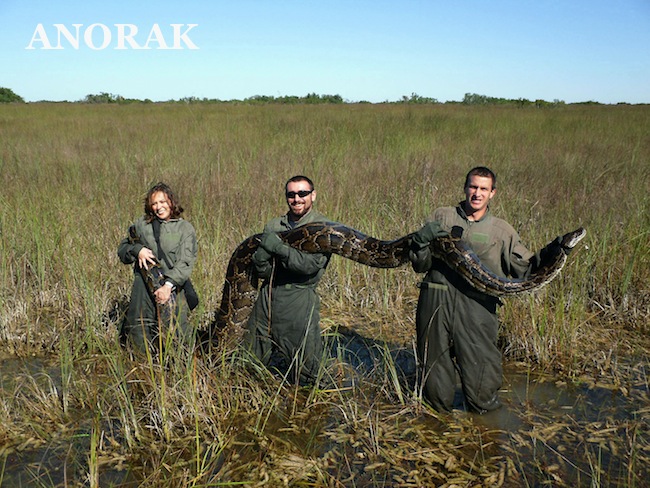On the Florida Everglades python hunt (photos)
THEY’RE python huntin’ in Florida’s Everglades. The hunters are after immigrant snakes.
The National Park Service, Florida Fish and Wildlife Commission and the South Florida Water Management District want pythons eradicated from the Everglades National Park and Big Cypress National Preserve.
The Times spots Mark Massingham, 46, a software-marketing specialist from Hatfield in Hertfordshire. He says, encouragingly of tracking beast that eat alligators:
“I’ve never been hunting before.”
What with there being no sea wasp boxy jellyfish, Great White Sharks or lions, the novice hunter should opt to follow Burmese pythons.
The best time to hunt the pythons is between 11 p.m. and 4 a.m.
Pro python hunter Greg Graziani has tips. His stated method is to grab the snake’s tail and hang on:
“I let it strike five to seven times. Each strike became more labored. I wait for it to tire itself out.”
Go that, Mark Massingham? You use only your bare hands.
“Python Dave” Leibman is another pro:
“I am stunned the state is allowing people to come out here with machetes and guns. Even though they’re not a cute cuddly dog or kitty cat they have feelings, too.”
The amateur python hunters will get to learn much from the masters of their craft.
Note to amateur hunters: The pro pythoniser’s grenades, AK47s and canon are for decorative purposes only. Really.
Prof Dorcas and his colleagues looked at data on mammals found during roadkill surveys from 1993-1999, and on live and dead mammals encountered during nighttime road surveys from 1996-1997. They then compared these results with similar data collected between 2003 and 2011, after the pythons were recognised as being established. They found that observations of raccoons and opossums had dropped by about 99%. There had been a 94.1% fall in observations of white-tailed deer and an 87.5% decrease in sightings of bobcats. No rabbits or foxes were seen during the more recent survey; rabbits were among the most common mammals in the roadkill survey between 1993 and 1999.
Fact: Rabbits can neither outrun massive snakes nor cars.
Photo 1 (above) In this November 14, 2009 photo provided by the University of Florida, University of Florida researchers hold a 162-pound Burmese python captured in Everglades National Park, Fla. Therese Walters, left, Alex Wolf and Michael R. Rochford, right, are holding the 15-foot snake shortly after the python ate a six-foot American alligator. The National Academy of Science report released Monday, Jan. 30, 2012, indicates that the proliferation of pythons coincides with a sharp decrease of mammals in the park.
In this Thursday, Oct. 27, 2011 photo provided by the National Park Service, Everglades National Park wildlife biologists Mark Parry, left, and Skip Snow perform a necropsy on a Burmese Python that was captured and killed in Everglades National Park, Fla. The 15.65-foot-long Python had recently consumed a 76-lb. adult female deer. The reptile was one of the largest ever found in South Florida. (AP Photo/National Park Service)
In this Thursday, Oct. 27, 2011 photo provided by the South Florida Water Management District, workers are shown holding a nearly 16-foot long Burmese Python that was captured and killed in Everglades National Park, Fla.
Cpt. Jeff Fobb, from the Miami-Dade Venmon Control department, displays a python during the kick-off ceremonies in Davie, Fla., Saturday, Jan. 12, 2013. The 13-foot snake was captured a year ago swimming in a backyard swimming pool.
Dan Keenan, a mechanical engineer, looks for python nests as he makes his way through the thick underbrush in the Big Cypess National Preserve, Saturday, Jan. 12, 2013.
Posted: 15th, January 2013 | In: Reviews Comment | TrackBack | Permalink







